Despite its relatively small size, the archipelagic nation of the Philippines boasts the fifth-highest number of plant species in the world, including some of the most striking flowers on Earth. Interestingly, the Filipino national flower, the sampaguita (Jasminium sambac), is not actually native to the country. But there are plenty of blooming beauties that do call the Philippines home. Here are 18 gorgeous flowers native to the Philippines.
1. Jade Vine (Strongylodon macrobotrys)
Also known as the emerald vine or turquoise jade vine, this flower was discovered in 1841 on Mount Makiling, on the Philippines’ Luzon Island.
The stems of this vining flower can reach lengths approaching 60 feet as it grows upward, intertwining with tree trunks and branches. The turquoise or green blooms can grow nearly 10 feet long. The beauty and rarity of this flower make it one of the most prized and expensive in the world.
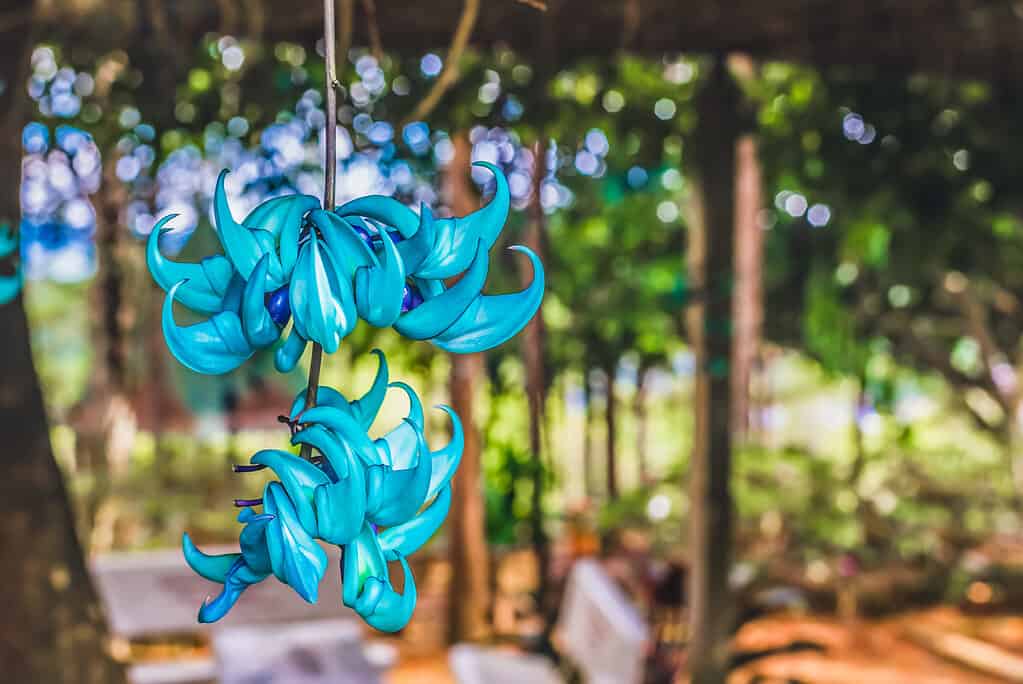
The turquoise blooms of the Jade Vine are some of the most sought-after in the world.
©POLLAWAT/Shutterstock.com
2. Ylang-ylang (Cananga odorata)
If you’re looking for a sweet-smelling flower, then look no further than the ylang-ylang (or ilang-ilang). This plant yields a fragrant essential oil that is widely used in the perfume industry, including such famous fragrances as Chanel No. 5. It is so sought-after by the fragrance industry that the ylang-ylang has been dubbed “The Queen of Perfumes.”
This greenish-yellow flower grows in the shape of a star on the Cananga tree, which can reach heights of 40 feet. It is native not only to the Philippines but also to Malaysia, Vietnam, the Solomon Islands, Thailand, Indonesia, and Queensland, Australia.
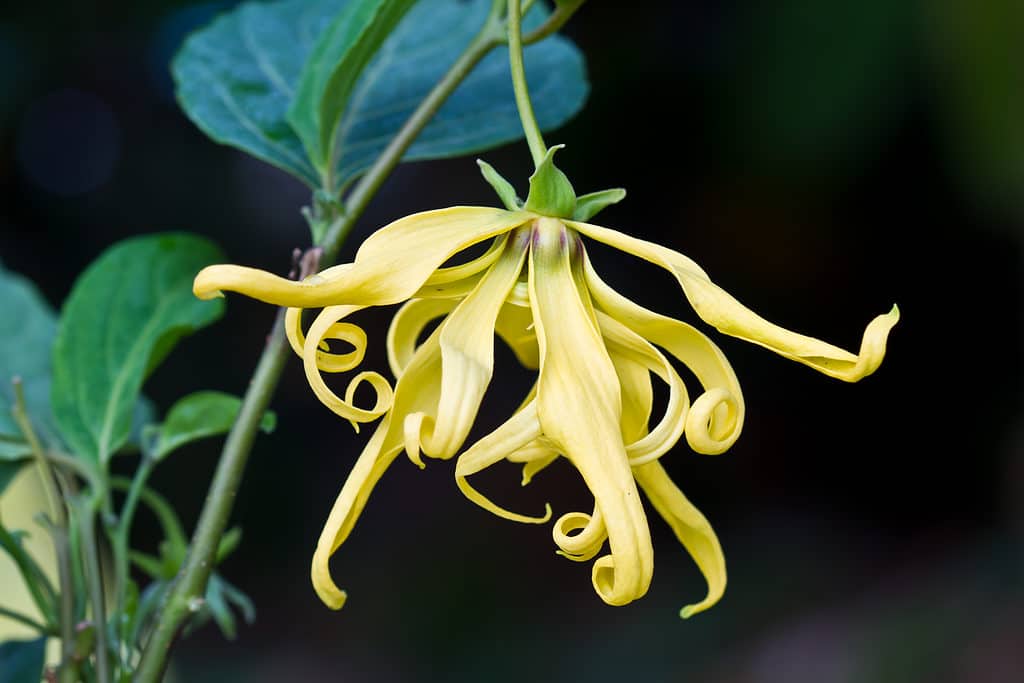
The ylang-ylang’s star-shaped bloom smells so sweet it’s also known as “The Queen of Perfumes.”
©pittaya/Shutterstock.com
3. Edible Amaranth (Amaranthus tricolor)
A member of the spinach family, the edible amaranth has primarily green leaves for much of the year. But in the summer, the leaves explode into color, displaying hues of red, yellow, and green. This multicolored spectacle is why the plant is also known as Joseph’s Coat, referring to the biblical story of Joseph and his coat of many colors.
The purple flowers that adorn this small shrub are valued for their decorative purposes but also as an ingredient in food and herbal medicines.

The purple leaves of the edible amaranth are a popular ingredient in food and herbal medicines.
©Anna Gratys/Shutterstock.com
4. Narra (Pterocarpus indicus)
Narra declared the national tree of the Philippines in 1934, is also known as Amboyna rosewood, Malay padauk, and Andaman redwood. The tree flowers from February to May, and its bright yellow blooms are magnets for pollinators. Human residents also look forward to the colors, as they are a source of tasty honey.
The hardwood of the trunk is used in both construction and art. This aromatic wood is also utilized in shampoo and tea.

The Narra is the national tree of the Philippines.
©Doikanoy/Shutterstock.com
5. Rafflesia
This flower, a parasitic plant in the family Rafflesiaceae, is both a sight and a scent to behold!
The flower has no observable root or stem. Rather, it blooms directly from its host plant. And what a bloom it is!
The five-petaled red flowers can grow to enormous size. One species features blooms that can measure up to 3 feet across, roughly the same length as a golf club.
But before you go in search of this giant, you should know that it is sometimes referred to as the “corpse lily” or corpse flower” due to its pungent stench. This malodorous flower might be offputting to us, but it is a favorite of flies and beetles, which help pollinate the plant.

The giant bloom of the raffliesia, while beautiful, smells terrible.
©Bpk Maizal/Shutterstock.com
6. Attenborough’s Pitcher Plant (Nepenthes attenboroughii)
This carnivorous pitcher plant is named after Sir David Attenborough, the world-renowned naturalist who has a particular affinity for the plant. And it’s easy to see why he’s so fascinated by it.
It is the largest carnivorous plant on earth, with pitchers that can grow close to 6 inches in diameter and nearly 1 foot high. These pitchers can hold over half a gallon of fluid.
These enormous pitchers are the perfect trap for the plant’s prey. Unlike many other carnivorous plants, Attenborough’s pitcher plant is not limited to catching insects. It can also snare frogs, lizards, small birds, and even rodents. Colloquially the plant is sometimes called the “Venus rat trap.”
Due in large part to plant poachers, this remarkable (and rather vicious) plant is considered critically endangered by the International Union for Conservation of Nature (IUCN).

The Attenborough’s pitcher plant uses its enormous pitcher to snare its prey.
©leungchopan/Shutterstock.com
7. Palawan Cherry Blossom (Avanica nodosa)
While Americans likely think of Washington, D.C., when they hear of cherry blossoms, the Palawan Cherry Blossom is found in tropical climates such as the Philippines.
This spring deciduous tree flowers display stunning pink and white blooms. These beautiful flowers make it very popular in ornamental gardens.
The particular subspecies that is native to the Philippines is locally referred to as balayong. Historically the flower has symbolized the beauty and strength of women and is celebrated during the Balayong Festival, which is observed every March.

The pink and white blooms of the Palawan cherry blossom tree appear in the spring.
©Chengzai8976/Shutterstock.com
8. Waling-waling (Vanda sanderiana)
The waling-waling is a species of orchid, also known as Sander’s Vanda after orchidologist Henry Frederick Conrad Sander.
The gorgeous blossoms feature an interplay of pinks and dark reds, and purples. The sweet fragrance of the flower makes it popular for perfume and home decor.
The waling-waling has become synonymous with much of Filipino culture, so much so that some have petitioned to make it the national flower of the Philippines instead of the non-native sampaguita. The indigenous Bagobo people even worship the flower as a deity.
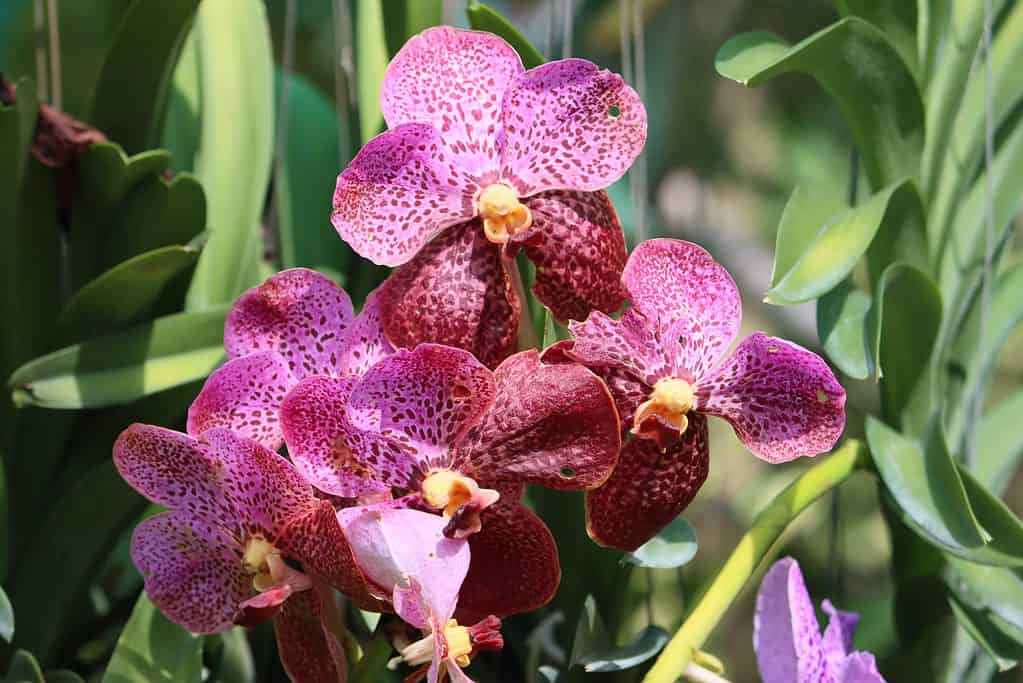
Many people see the deep colors of the waling-waling as symbolic of much of Filipino culture.
©Kolinchev Andrii/Shutterstock.com
9. Rose Grape (Medinilla magnifica)
The rose grape is an epiphyte, meaning it grows on trees but does not draw nutrients from those trees as parasitic plants do. It can grow to nearly 10 feet tall, the same height as a standard basketball hoop. It is aptly named the rose grape because of the sweet, edible berries it produces, although many mistakenly believe the berries are poisonous.
Other names for the rose grape include the showy Medinilla, the Philippine orchid (though it is not actually part of the family Orchidae), the pink lantern tree, the chandelier tree, and the love plant.

The berries of the rose grape are often falsely believed to be poisonous.
©SariMe/Shutterstock.com
10. Foxtail Orchid (Rhyncostylis retusa)
Like the rose grape, the foxtail orchid is also an epiphyte.
Its blooms burst forth in the spring, creating one of the loveliest floral scenes found anywhere on earth. The plant is named for its long pendant shape, resembling a fox’s tail, which can reach 15 inches long (the same length as a bowling pin). In full bloom, the plant displays more than 100 white and pink-spotted flowers.
Historically, the foxtail orchid has been used for medicinal purposes throughout Asia, as it was believed to treat everything from menstrual disorders to tuberculosis.
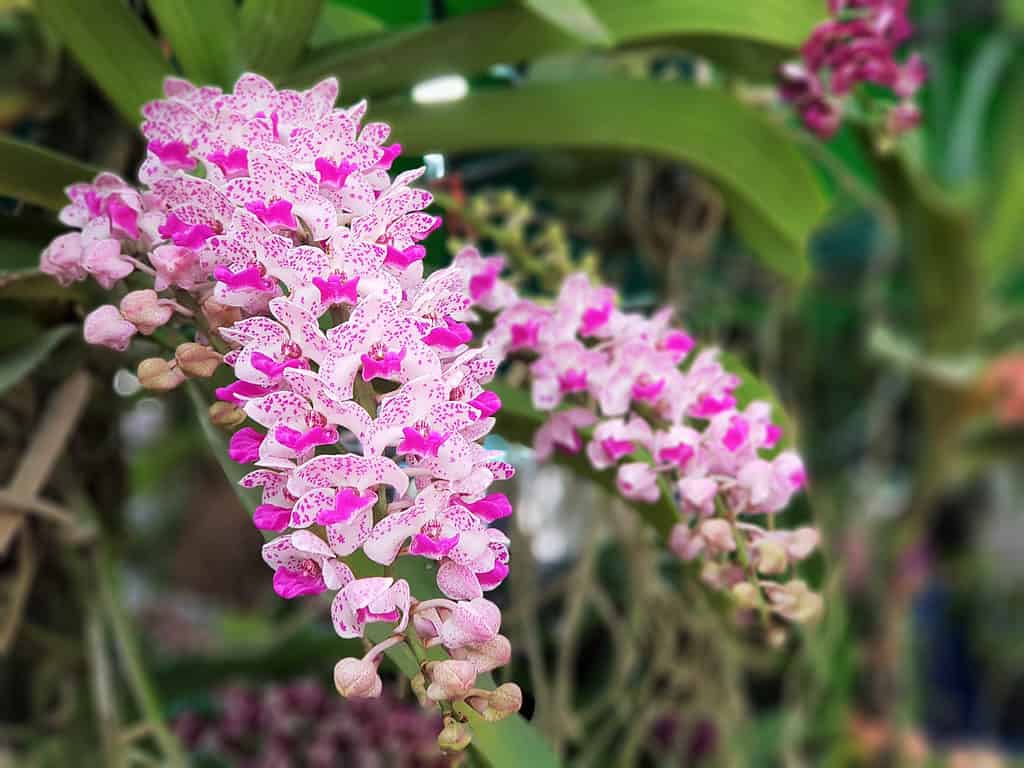
The long blooms of the foxtail orchid are said to resemble a fox’s tail.
©Arunee Rodloy/Shutterstock.com
11. Monarch Rosemallow (Hibiscus radiatus)
Also known as the rayed hibiscus, the monarch rosemallow boasts a beautiful mauve bloom with a purple center. This hibiscus can grow over three feet tall with thorny stems.
Due to their shape, the leaves of the monarch rosemallow are often mistaken for the cannabis plant (marijuana).
It is often eaten with vegetables or used as a medicinal herb.
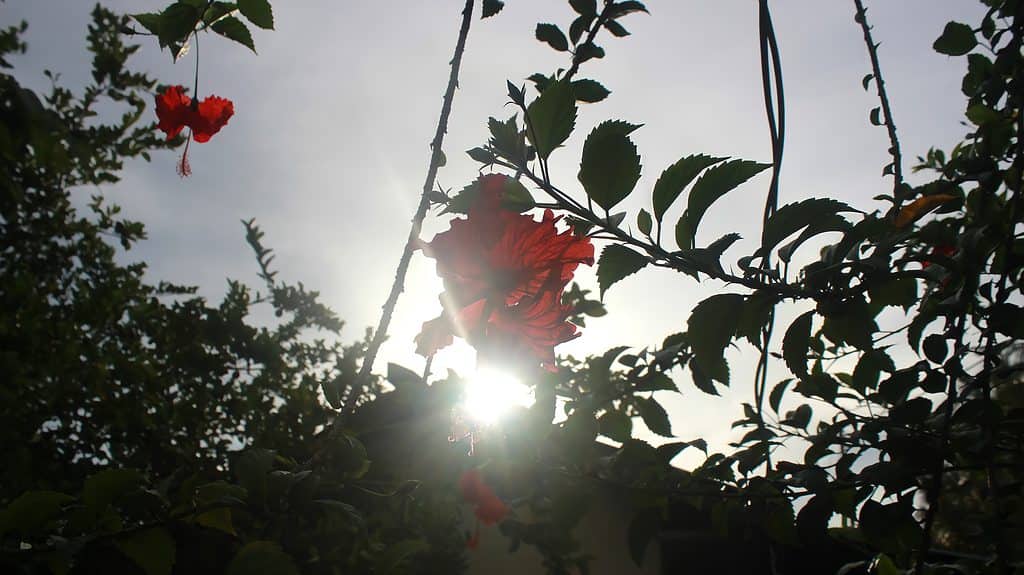
The monarch rosemallow is edible and is often paired with vegetables.
©herryN/Shutterstock.com
12. Water Lilies
There are two native species of water lilies in the Philippines: the star lotus and the hairy water lily.
Both species can be found in freshwater lakes and ponds. While the leaves (often called lily pads) and flowers of the plant appear to float on the water surface, they are actually attached to a submerged stem that is rooted in the muddy floor of the lake or pond.
The star lotus features blue or purple petals, while the petals of the hairy water lily (named for their “hairy” underwater stem) can be pink, purple, or white.
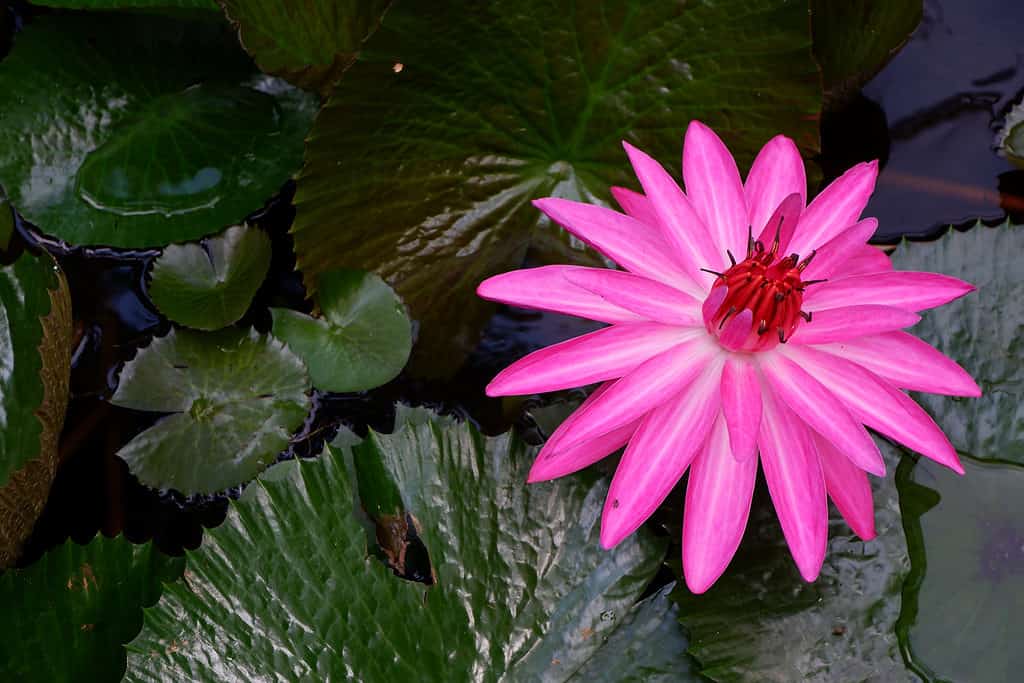
The beautiful hairy water lily has a submerged “hairy” stem.
©Sije18/Shutterstock.com
13. Grape-Leaved Anemone (Eriocapitella Vitifolia)
The grape-leaved anemone is the only species of anemone found in the Filipino archipelago. Its leaves resemble those of a grapevine; hence the name grape-leaved anemone. It is also less commonly known as the grape-leaved windflower.
This plant is rather small, growing no more than 2 feet tall. Atop its stem is a large flower with a white or pinkish-purple bloom.
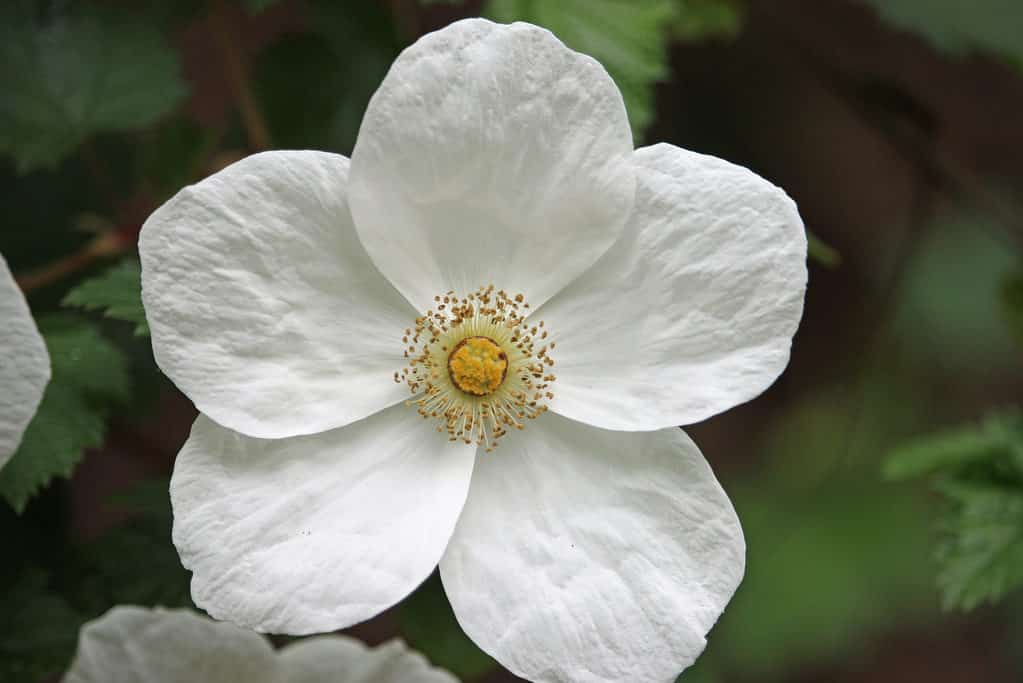
The grape-leaved anemone displays a large white (and sometimes pink) flower.
©JohnatAPW/Shutterstock.com
14. Easter lily (Lilium longiflorum)
The Easter lily is endemic to the northern Philippines, as well as Taiwan and Japan.
Its stem can grow to over 3 feet and is adorned with multiple large outward-facing flowers that bloom from April – June. The trumpet-shaped flowers are quite aromatic, with a fresh, floral scent.
The Easter lily has come to symbolize the resurrection of Jesus Christ in the Christian faith and is prevalent in many churches during Eastertide. However, to ensure that they are in full bloom for the Easter holiday (which can fall on any date between March 22 and April 25), conditions are altered to force cultivated plants to bloom earlier than they otherwise would in the wild.

The iconic Easter lily can grow over 3 feet tall.
©Peter Krisch/Shutterstock.com
15. Paphiopedilum Philippinense
If you’re searching for a beautifully unique flower, search no more. The Paphiopedilum Philippinense is just that.
Paphiopedilum Philippinense is an orchid species found from the Philippines all the way to northern Borneo. It’s also referred to as a type of Venus Slipper because of the flower’s slipper-shaped pouches.
This rather small plant, topping out at 19 inches tall, can grow in a variety of conditions. It can be found growing from the ground, from trees, and even out of rocky crags.
The yellow slipper-like pouch, called a lip, has a pleasant fragrance and contains nectar that draws pollinators. The petals of this flower are brown in color and extend downward in a twisted, ribbon-like shape.
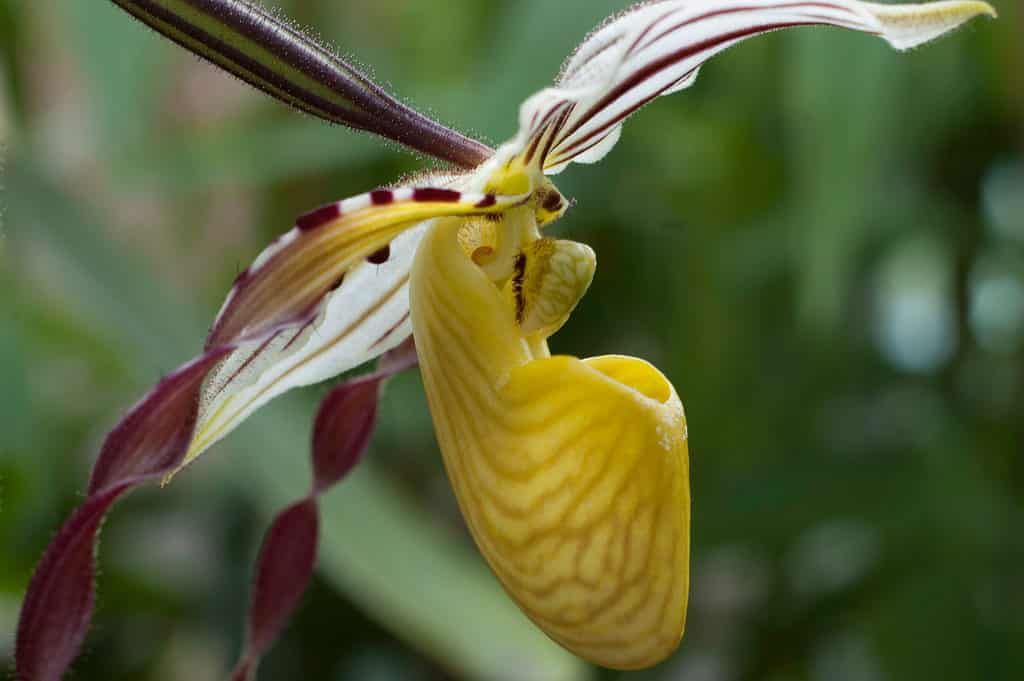
The yellow lip of a Paphiopedilum Philippinense is a pollinator’s delight.
©Isroi/Shutterstock.com
16. Aster
The aster gets its name from the Greek word astron, meaning “star.” The star-shaped bloom demonstrates why the name was chosen.
An aster can grow up 4 feet tall and appears to be a rather simple flower. But closer inspection reveals that the yellow disc in the center is actually made up of many tiny flowers, numbering in the hundreds. The much larger petals protruding from the disc are called ray florets.
Asters belong to the same family as daisies and sunflowers. Two different species of aster are found in the Philippines: Aster trinervius (featuring purple ray florets) and Aster philippinensis (with white ray florets).
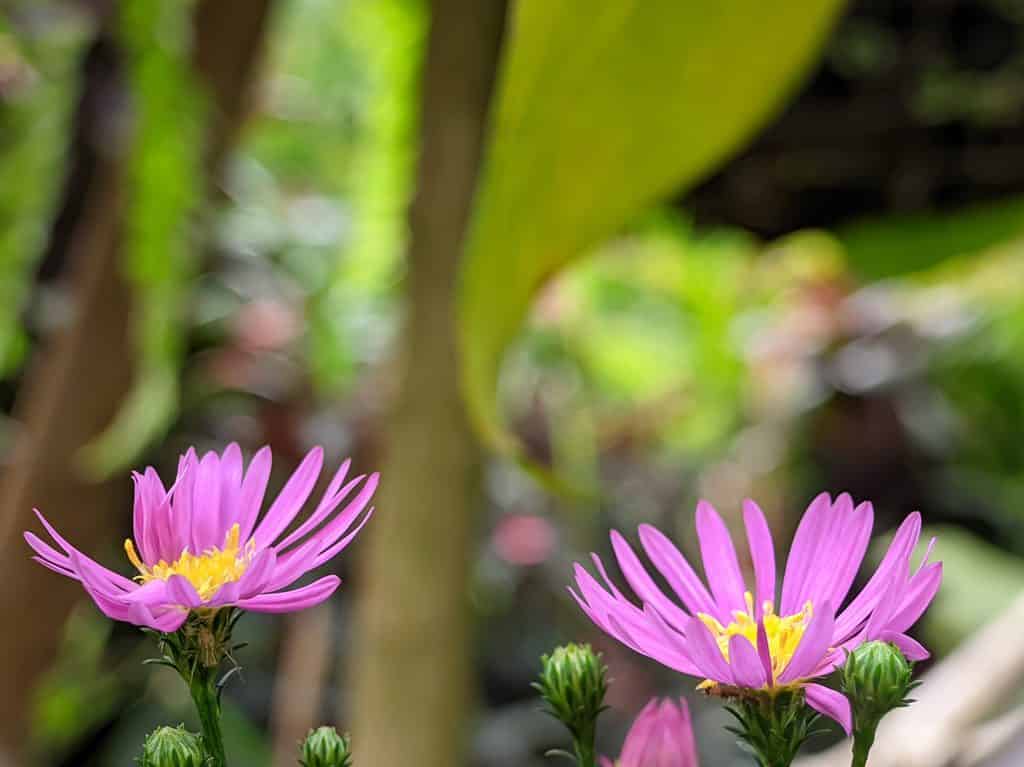
The aster has a star-shaped bloom.
©Baroen/Shutterstock.com
17. Queen of Philippines (Mussaenda philippica)
The Queen of Philippines is a large shrub that can reach heights of 10 feet in the wild but remains much smaller in domestic environments.
The colors can vary widely depending on the varieties, which include “Queen Sirikit” (light pink), “Doña Laz” (pink), “Alicia Luz” (dark pink), “Doña Aurora” (white), and “Doña Envangellina” (dark red).
Its beauty and versatility make it a popular ornamental plant for public greenspaces and roadsides.
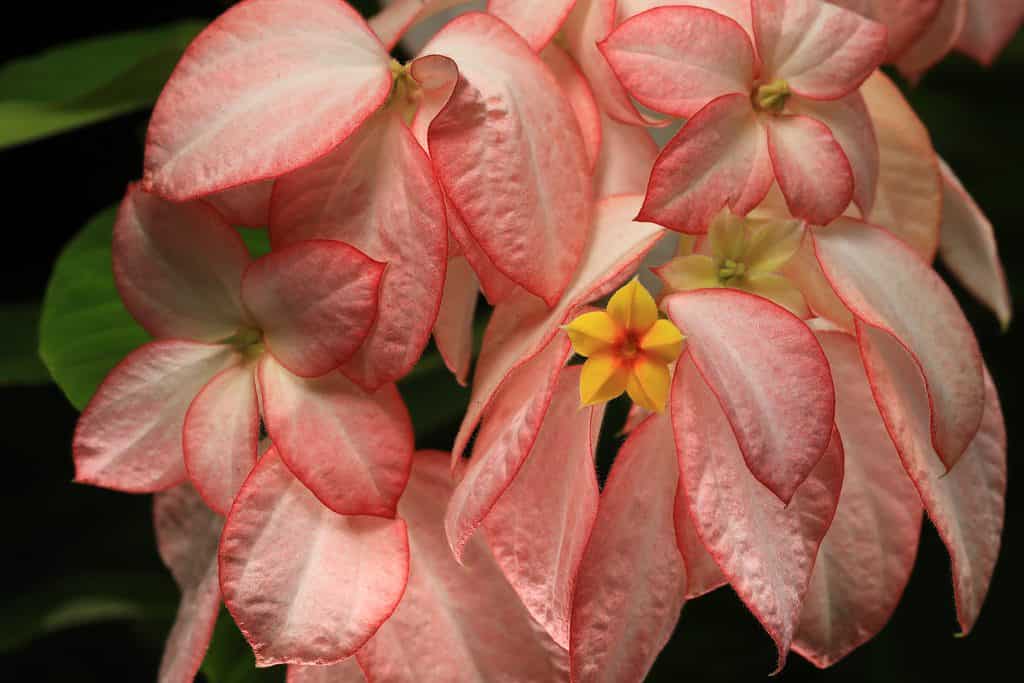
The light pink blooms of the Queen Sirikit variety represent only one of many different colors and varieties of this flower.
©Jamikorn Sooktaramorn/Shutterstock.com
18. Red silk-cotton (Bombax ceiba)
This tree, found in coastal regions, usually stands around 60 feet tall. Older trees, though, can reach heights nearing 200 feet. The tree’s trunk is covered with spikes to protect it from potentially destructive animals.
The “red” in the tree’s name is because of the bright red, cup-shaped blooms with five petals that appear in the spring before the new foliage. Viewed at a distance, a tree covered in these red blooms can actually appear to be ablaze.
It is referred to as “silk-cotton” because the flowers produce a capsule that, when ripe, contains white fibers similar to cotton. The fibers are used to fill pillows and blankets and in ropemaking.
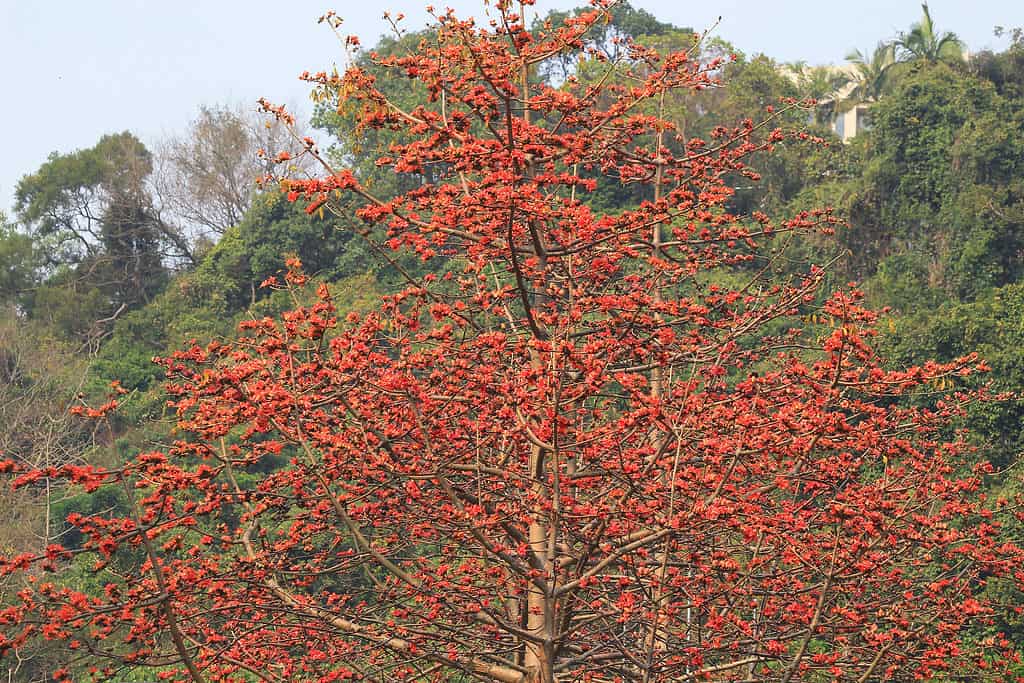
When seen from a distance, the red silk-cotton tree appears to be on fire.
©seaonweb/Shutterstock.com
Final Thoughts
The Philippines is one of only 17 mega-biodiverse countries worldwide, including much larger nations such as Brazil, China, and the United States. Considering the number of wonderful, stunning flowers that are endemic to the archipelago, it’s easy to see why this relatively small nation has earned such a distinction.

The Philippines is a mega-biodiverse country.
©Hlib Shabashnyi/Shutterstock.com
The photo featured at the top of this post is © cristan pago74/Shutterstock.com
Sources
- https://www.wikipedia.org/, Available here: https://www.wikipedia.org/
- Errah Caunca (1970) https://owlcation.com/stem/12-Flower-from-the-Philippines-The-Most-Beautiful-in-the-World ERRAH CAUNCA
- Cedie Salido, Available here: https://primer.com.ph/tips-guides/2022/03/18/7-unique-flowers-in-the-philippines/
Thank you for reading! Have some feedback for us? Contact the AZ Animals editorial team.






